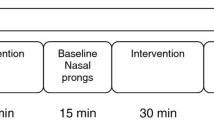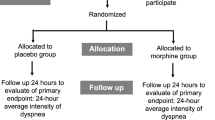Abstract
Background
Dyspnoea is a complex experience of the body and the mind. Whereas the effects of opioids on dyspnoea in advanced disease have been the focus of studies for management of dyspnoea in palliative medicine, the role of oxygen is still unclear. The effects of symptomatic oxygen and opioid treatment on ventilation and palliation of dyspnoea in hypoxic (H) and non-hypoxic (NH) palliative care patients were assessed and compared.
Methods
In a prospective, non-randomised study, 46 patients with mild to severe dyspnoea were included. Transcutaneous measurement (earlobe sensor) of carbon dioxide partial pressure (tcpaCO2), pulse oximetry oxygen saturation (SaO2) and pulse frequency (PF) were monitored with SenTec digital monitor. Compared was: baseline data of the continuously documented respiratory parameters for about 15 min in patients breathing room air at admission, 60 min during nasal O2 insufflation, and 30, 90 and 120 min after the first opioid application and without O2 insufflation.
Results
Whereas opioid application resulted in a significant decrease in the intensity of dyspnoea and respiratory rate, during the nasal O2 insufflation (4 l/min), there was no significant decrease in the intensity of dyspnoea neither in H (P = 0.564) nor in NH (P = 0.096) patients. There was no evidence of a significant correlation between the intensity of dyspnoea and oxygen saturation. The Spearman rank correlation in NH patients was −0.080 (P = 0.686) and in H patients P = 0.296 (P = 0.233). No significant differences between the groups of hypoxic and non-hypoxic patients with regard to tcpaCO2 increase (P = 0.075 NH; P = 0.346 H) or SaO2 decrease after opioid application (P = 0.077) were found.
Conclusions
In this study, opioids worked significantly better than oxygen in reducing the intensity of dyspnoea even in hypoxic patients. There was no correlation between intensity of dyspnoea and oxygen saturation in H and NH patients. Oxygen should be seen as a pharmacological agent and not be given based on intuitive assumption of benefit.





Similar content being viewed by others
References
Ahmedzai S, Laude E, Robertson A, Troy J, Vora V (2004) A double-blind, randomised, controlled phase 2 trial of Heliox28 gas mixture in lung cancer patients with dyspnoea on exertion. Br J Cancer 90:366–371
Allard P, Lamontagne C, Bernard P et al (1999) How effective are supplementary doses of opioids for dyspnea in terminally ill cancer patients? A randomized continuous sequential clinical trial. J Pain Symptom Manage 17:256–265
Banzett RB, Mulnier HE, Murphy K et al (2000) Breathlessness in humans activates insular cortex. Neuroreport 11:2117–2120
Barbour SJ, Vandebeek CA, Ansermino JM (2004) Increased tidal volume variability in children is a better marker of opioid-induced respiratory depression than decreased respiratory rate. J Clin Monit Comput 18(3):171–178
Bercovitch M, Waller A, Adunsky A (1999) High-dose morphine use in the hospice setting. Cancer 86:871–877
Booth S, Anderson H, Swannick M, Wade R, Kite S, Johnson M (2004) The use of oxygen in the palliation of breathlessness. A report of the expert group of the scientific committee of the association of palliative medicine. Respir Med 98:66–77
Booth S, Kelly M, Cox N, Adams L, Guz A (1996) Does oxygen help dyspnoea in patients with cancer. Am J Respir Crit Care Med 153:1515–1518
Bouillon T, Bruhn J, Roepcke H et al (2003) Opioid-induced respiratory depression is associated with increased tidal volume variability. Eur J Anaesthesiol 20(2):127–133
Brannan S, Liotti M, Egan G et al (2001) Neuroimaging of cerebral activations and deactivations associated with hypercapnia and hunger for air. Proc Natl Acad Sci U S A 98:2029–2034
Bruera E, de Stoutz N, Velasco-Leiva A, Schoeller T, Hanson J (1993) Effect of oxygen on dyspnoea in hypoxaemic terminal cancer patients. Lancet 342(8861):13–14
Bruera E, MacEachern T, Ripamonti C et al (1993) Subcutaneous morphine for dyspnea in cancer patients. Ann Intern Med 119:906–907
Bruera E, Scholler T, MacEachern T (1992) Symptomatic benefit of supplemental oxygen in hypoxemic patients with terminal cancer: the use of the N of 1 randomised controlled trial. J Pain Symptom Manage 7(6):365–368
Chua TP, Harrington D, Ponikowski P et al (1997) Effects of dihydrocodeine on chemosensitivity and exercise tolerance in patients with chronic heart failure. J Am Coll Cardiol 29:147–152
Clemens KE, Klaschik E (2007) Symptomatic therapy of dyspnoea with strong opioids and its effect on ventilation in palliative care patients. J Pain Symptom Manage 33(4):473–481
Clemens KE, Klaschik E (2007) Symptomatic treatment of dyspnoea in patients receiving palliative care: nasal delivery of oxygen compared with opioid administration. Dtsch Med Wochensch 132:1939–1943
Clemens KE, Quednau I, Klaschik E (2008) Is there higher risk of respiratory depression in opioid-naïve palliative care patients during symptomatic therapy of dyspnoea with strong opioids. J Palliat Med 11(2):204–216
Cohen RM, Carson RE, Channing M et al (1988) F-18-Cyclofoxy PET imaging in man. J Nucl Med 29:796
Cuvelier A, Grigoru B, Molano LC et al (2005) Limitations of transcutaneous carbon dioxide measurements for assessing long-term mechanical ventilation. Chest 127:1744–1748
Dean N, Brown J, Hotelman R et al (1992) Oxygen may improve dyspnoea and endurance in patients with chronic obstructive pulmonary disease and only mild hypoxemia. Am Rev Respir Dis 146:941–945
Eberhard P, Gisiger PA, Gardaz JP et al (2002) Combining transcutaneous blood gas measurement and pulse oximetry. Anesth Analg 94(Suppl):76–80
Edwards MJ (2005) Opioids and benzodiazepines appear paradoxically to delay inevitable death after ventilator withdrawal. J Palliat Care 21(4):299–302
Escalante CP, Martin CG, Eiting LS, Cantor SB, Harle TS, Price KJ et al (1996) Dyspnea in cancer patients. Etiology, resource utilization, and survival—implications in a managed care world. Cancer 78(6):1314–1319
Evans KC, Banzett RB, Adams L et al (2002) BOLD fMRI densifies limbic, paralimbic, and cerebellar activation during air hunger. J Neurophysiol 88:1500–1511
Frost JJ, Wagner HN Jr, Dannals RF et al (1985) Imaging opiate receptors in the human brain by positron tomography. J Comput Assist Tomogr 9:231–236
Garrod R, Paul EA, Wedzicha JA (2000) Supplemental oxygen during pulmonary rehabilitation in patients with COPD with exercise hypoxaemia. Thorax 55(7):539–543
Gaytan SP, Pasaron R (1998) Connections of the rostral ventral respiratory neuronal cell group: an anterograde and retrograde tracing study in the rat. Brain Res Bull 47:625–642
Hanly PJ (1998) Transcutaneous monitoring of carbon dioxide tension. In: Tobin MJ (ed) Principles and practice of intensive care monitoring. McGraw-Hill, New York, pp 401–414
Heyse-Moore LH, Ross V, Mullee MA (1991) How much of a problem is dyspnoea in advanced cancer. Palliat Med 5:20–26
Higginson I, Mc Carthy M (1989) Measuring symptoms in terminal cancer care: are pain and dyspnoea controlled. J R Soc Med 82:264–267
Johnson MJ, McDonagh TA, Harkness A et al (2002) Morphine for the relief of breathlessness in patients in chronic heart failure—a pilot study. Eur J Heart Fail 4:753–756
Ko S, Goldstein DH, VenDenKerkhof EG (2003) Definitions of “respiratory depression” with intrathecal morphine postoperative analgesia: a review of the literature. Can J Anesth 50(7):679–688
Leggett RJ, Finley DC (1977) Portable oxygen and exercise tolerance in patients with chronic hypoxic cor pulmonale. BMJ 2:84–86
Liotti M, Brannan S, Egan G et al (2001) Brain responses associated with consciousness of breathlessness (air hunger). Proc Natl Acad Sci U S A 98:2035–2040
Nunn JF (1975) Applied respiratory physiology with special reference to anaesthesia. Butterworths, London
Parsons LM, Egan G, Liotti M et al (2001) Neuroimaging evidence implicating cerebellum in the experience of hypercapnia and hunger for air. Proc Natl Acad Sci U S A 98:2041–2046
Pauwels RA, Buist AS, Calverley PMA et al (2001) Global strategy for the diagnosis, management, and prevention of chronic obstructive pulmonary disease: National Heart, Lung, and Blood Institute and World Health Organization Global Initiative for Chronic Obstructive Lung Disease (GOLD): executive summary. Respir Care 46:798–825
Pfeiffer C, Poline JB, Thivard L et al (2001) Neural substrates for the perception of acutely induced dyspnea. Am J Respir Crit Care Med 163:951–957
Philip J, Gold M, Milner A, Di Iulio J, Miller B, Spuryt O (2006) A randomised, double blind, crossover-trial of the effect of oxygen on dyspnoea in patients with advanced cancer. J Pain Symptom Manage 32(6):541–550
Roberts C (2004) Short-burst oxygen therapy for relief of breathlessness in COPD. Thorax 59:638–634
Rosner V, Hannhart B, Chabot F et al (1999) Validity of transcutaneous oxygen/carbon dioxide pressure measurement in the monitoring of mechanical ventilation in stable chronic respiratory failure. Eur Respir J 13:1044–1047
Spathis A, Wade R, Booth S (2006) Oxygen in the palliation of breathlessness. In: Booth S, Dudgeon D (eds) Dyspnoea in advanced disease. Oxford University Press, Oxford, pp 205–236
Thorns A, Sykes N (2000) Opioid use in last week of life and implications for end-of-life decision making. Lancet 3556:398–399
Waterhouse JC, Howard P (1983) Breathlessness and portable oxygen in chronic obstructive airways disease. Thorax 38:302–306
Wedzicha JA (1999) Domiciliary oxygen therapy services: clinical guidelines and advice for prescribers. Summary of a report of the Royal College of Physicians. J R Coll Physicians Lond 33:445–447
Woodcock AA, Gross ER, Geddes DM (1981) Oxygen relieves breathlessness in ‘pink puffers’. Lancet 1:907–909
Acknowledgements
The authors would like to thank Birgit Jaspers for careful review of this manuscript and English editing.
This study is sponsored by Deutsche Krebshilfe e.V. (German Cancer Aid). The sponsor had no impact on the investigator-initiated work of the authors.
Author information
Authors and Affiliations
Corresponding author
Rights and permissions
About this article
Cite this article
Clemens, K.E., Quednau, I. & Klaschik, E. Use of oxygen and opioids in the palliation of dyspnoea in hypoxic and non-hypoxic palliative care patients: a prospective study. Support Care Cancer 17, 367–377 (2009). https://doi.org/10.1007/s00520-008-0479-0
Received:
Accepted:
Published:
Issue Date:
DOI: https://doi.org/10.1007/s00520-008-0479-0




